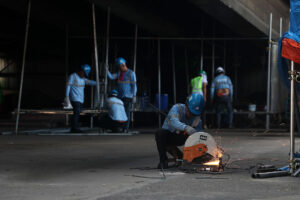




Quarterly Economic Growth Release: More BSP cuts to come
 DOWNLOAD
DOWNLOAD

Monthly Economic Update: Fed catches up
 DOWNLOAD
DOWNLOAD

Inflation Update: Steady and mellow
 DOWNLOAD
DOWNLOAD


Infrastructure spending increased by 15% in March, says Budget dep’t

State spending on infrastructure rose by 15% in March as the government ramped up disbursements for public works and defense modernization projects, the Department of Budget and Management (DBM) said.
In its latest National Government (NG) disbursement report, spending on infrastructure and other capital outlays jumped by 15.1% to PHP 96.3 billion in March from PHP 83.7 billion in the same month last year.
Month on month, infrastructure spending rose by a fifth from PHP 79.4 billion in February.
The uptick in March was attributed mainly to the Department of Public Works and Highways’ (DPWH) increased spending for the construction of road infrastructure.
“The sharp increase was largely due to the strong spending performance of the DPWH for payment of progress billings (i.e., completed/partially completed works) for various road infrastructure programs (e.g., road and bridge networks, flood control/mitigation structures, right-of-way acquisition), alongside payment of mobilization fees/advances to contractors for infrastructure projects under the 2024 budget,” the department said in a press release.
Infrastructure spending rose due to direct payments made by the Department of Transportation for foreign-assisted railway projects such as the Capacity Enhancement of Mass Transit Systems in Metro Manila and the Malolos-Clark Railway Project.
The DBM said disbursements for the Department of National Defense’s (DND) Armed Forces of the Philippines (AFP) modernization program also contributed to the higher spending.
For the first quarter, infrastructure and other capital outlays went up by 10.2% to PHP 216.8 billion from PHP 196.7 billion in the same period in 2023.
Overall infrastructure disbursements, which include infrastructure components of subsidy/equity to government corporations and transfers to local government units (LGUs), rose by 9.3% year on year to PHP 266.3 billion in the period ending March.
“The sturdy growth of the total infrastructure spending resulted mainly from the implementation of road infrastructure projects of the DPWH and defense modernization projects of the DND, alongside the higher local development fund of LGUs — equivalent to 20% of their National Tax Allotment shares,” the department said.
The Philippine Statistics Authority earlier reported that government-led construction grew by 12.4% in the first quarter, contributing 2.9 percentage points (ppts) to the construction sector’s 6.8% growth and around 0.44 ppt to the 5.7% quarterly gross domestic product (GDP) growth.
Terry L. Ridon, a public investment analyst and convenor of think tank InfraWatch PH, said that efficient spending of public funds helped the government outpace last year’s infrastructure spending performance so far.
“This means that the government has been more efficient in the disbursement of public funds compared to the previous year, particularly in terms of improving the absorptive capacity of agencies to implement projects,” he said in a Viber message.
“What the government needs to avoid would be unexpected project delays, such as right-of-way concerns which can delay project implementation for months, even years,” he added.
President Ferdinand R. Marcos, Jr. earlier issued several Executive Orders to fast-track the approval process for the government’s infrastructure flagship projects as well as address right-of-way concerns.
The DBM expects infrastructure spending to increase in the second quarter as the government ramps up construction projects and activities before the rainy season.
“Disbursements are foreseen to gradually increase in the current quarter as the DPWH and other agencies with capital outlay projects capitalize on the summer season for their construction projects/activities.”
Spending on government programs in health, education, agriculture, social and employment as well as the release government employees’ midyear bonus would also spur economic growth, DBM added.
Government employees started receiving their midyear bonus on May 15.
“These would hopefully help stir more economic activity and prop up growth, particularly in public construction, the services and industry sectors, as well as household final consumption,” it said.
Rizal Commercial Banking Corp. Chief Economist Michael L. Ricafort expects faster infrastructure spending in the coming months.
“There would be greater urgency to accelerate infrastructure spending and other government spending on other projects and programs, especially later in 2024 up to early 2025 in view of the preparations for the May 2025 midterm elections,” he said in a Facebook Messenger chat.
He said the government needs to boost infrastructure spending to drive economic activity, noting that lackluster infrastructure spending had contributed to slower economic growth in 2023 and early 2024.
The government’s infrastructure program for this year is set at PHP 1.472 trillion, equivalent to 5.6% of GDP.
This article originally appeared on bworldonline.com





 By BusinessWorld
By BusinessWorld